
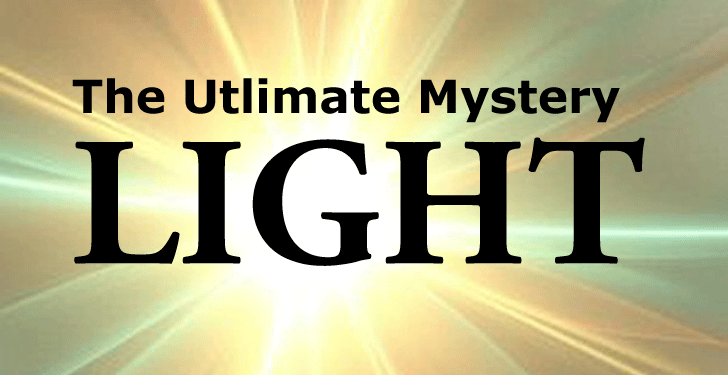
The Ultimate Mystery: What is light?
In the following four pages of this article, you will learn that there is a mysterious link between your consciousness and the properties of a photon, the basic unit of electromagnetic energy. You will see how your consciousness has reversed the flow of time in laboratory experiments, changed the course of light from being a straight line and how what you know as "reality" is explained by some noted physicists as an elaborate digital simulation, in which you and I are characters (avatars). It's all real -- no conjecture. This story will blow your mind -- if it does not then it means you do not understand it yet!
In the 19th century, scientists began to delve into the basic structure of the universe in an attempt to understand how it was put together. In one very simple experiment they sought to determine the nature of light, but the results were unexpected and created a mystery that the greatest minds have been unable to solve to this day.
To a physicist, light means an energy that is anywhere along the electromagnetic spectrum, from ELF waves to gamma radiation. Visible light is only a narrow part of the spectrum that is most familiar to us because our eyes can detect it. In the Newtonian model of the universe everything is made of particles, including light. Scientists began to think of light as being made from tiny "balls" of energy called photons.
In 1803 a physician named Thomas Young had been studying sound waves and thought that light was also a phenomenon involving waves. This contradicted the current theory. Young noticed that light could be slowed as it passed through a prism and the observed spectrum of colors seemed to be more easily explained as wave phenomenon rather than that of light "particles".
Young decided he would conduct an experiment that would finally resolve the conflict. What he could not have known is that this experiment would open up a pandora's box of brain-twisting enigmas that contradict our understanding of the universe and our own reality.
As you will see, the result of this experiment is a glimpse into another dimension where time itself can move backwards or stand still. This mystery has been with us for over 200 years now and we are no closer to solving it today. But when and if it is finally understood, civilization will dramatically change and our reality will have to be reconstructed.
The Double Slit Experiment (1803)
Thomas Young tried to keep things simple. He looked for examples in our everyday experience that revealed if things were solid particles or oscillating waves. I will attempt to explain his experiment using more modern analogies so that it will hopefully be easier to understand.
Let's imagine that you have a wide cement wall with an open, rectangular window cut in it. At some distance beyond the cement wall there is second wall. This second wall is made of thin wallboard and has no window. You're going to stand at some distance in front of the first wall and the window. You have a pistol [represented by the triangle below] and you begin shooting through the window. As you do this, you notice that the bullets are passing through the open window and hitting the second wall where they make holes.
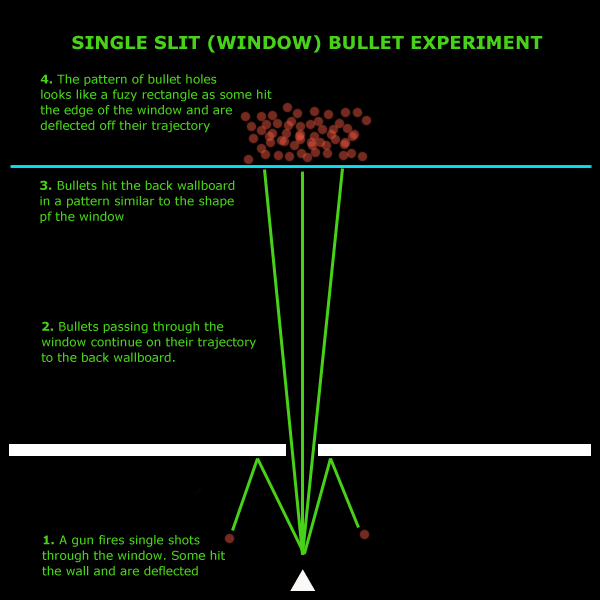
Because you are at some distance from the window (and presumably not a marksman), your bullets vary in their direction with each shot you take. After you have taken hundreds of shots you notice that the pattern of holes in the wallboard resemble the shape of the rectangular window. This is really not surprising and makes perfect sense.
Now we are going to add a second rectangular window a couple of feet to the left of the first window and begin shooting again [see below]. Because we are at some distance from the two windows, some of our bullets will randomly go through one or the other window. Some may even hit the wall and not go through either window. Some will hit the edge of the window and their trajectory will be slightly altered. But enough pass through either window so that there is a pattern of holes on the wallboard that now resembles two rectangles. Again, this is not surprising and is what we would expect in the world with which we are familiar.
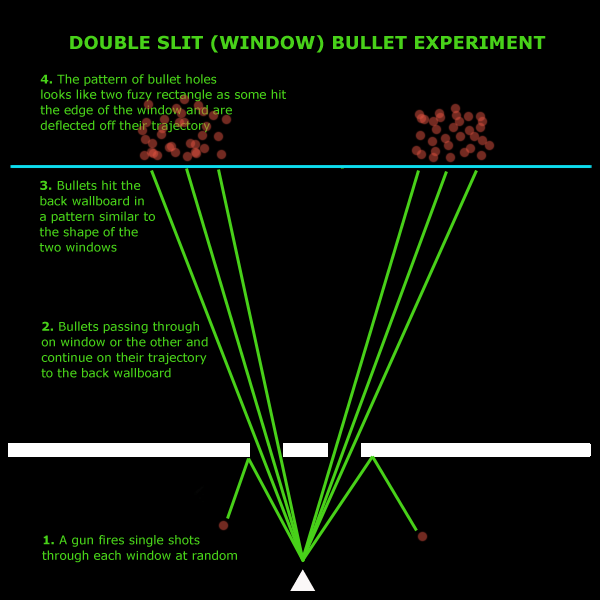
Bullets are solid objects, all the same size and weight and, although their trajectory through one or the other window is somewhat random, we nonetheless can see a distinct pattern on the wallboard.
Next, Young imagined the same two walls immersed in a pool of water. Instead of bullets, let's imagine we have something that generates a wave in the water. Like the example above we will start with only one open window.
As illustrated below, when the wave reaches the open window it passes through it and begins again on the other side, heading for the wallboard [2]. This time we will not have holes from bullets so we will have to find a way to measure the intensity of the wave. I suggest we imagine floating pin-pong balls that can move up and down against the wallboard so we will know when the wave hits the second wall.
With just the one window we have the strongest part of the wave hitting the area in back of the window with less intensity on each side. Again, there is nothing surprising here.
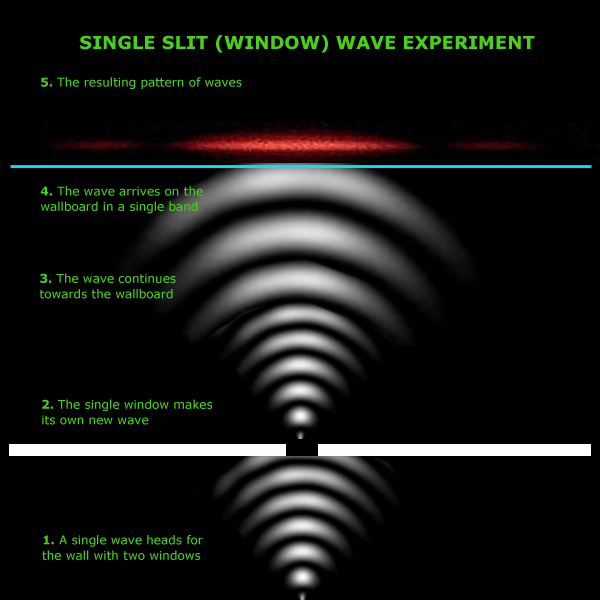
Lets go ahead and use a wall with two windows, like we did before (see below illustration). The initial wave approaches the windows [1], is stopped by the wall but becomes two new waves as it emerges on the other side of the windows [2]. These two waves continue towards the back wall [3], but something interesting happens. Sometimes the peaks of the two waves combine and become a stronger wave. Sometimes the troughs of both waves combine and become a deeper trough. Sometimes a peak and a trough combine and cancel each other and there is no wave. The resulting waves [4], as measured by our ping-pong balls on the wallboard will show a series of bands where the peaks have combines and no wave activity where they have cancelled each other.
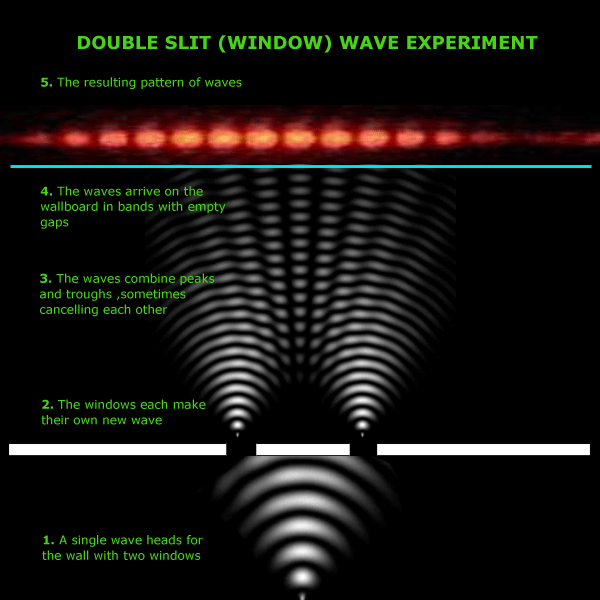
Unexpected Results Baffle Scientists, Even Today
What Thomas Young did was establish two distinct patterns that would happen in the two slit (or two windows in our example) experiment. If the energy directed towards the two slits was a solid particle, it would make two distinct (yet a little fuzzy around the edges) patterns. If the energy was in the form of a wave it would form bands, called an "interference pattern" by experimenters since the two waves from the windows interfere with each other.
What happened next puzzled Thomas Young and it has freaked out scientists and theoreticians like Albert Einstein, Steven Hawking, Richard Feynman and many others for over 200 years.
Comments:
<